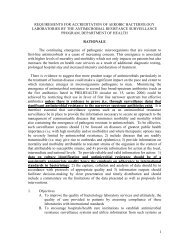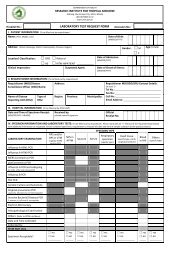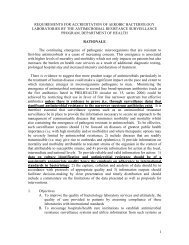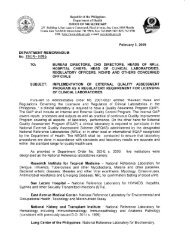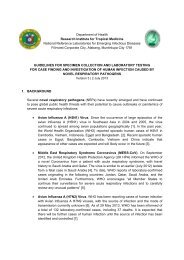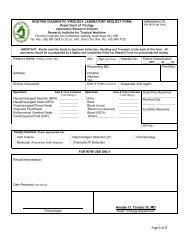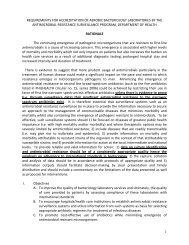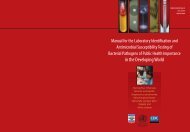guidelines for laboratory confirmation of suspected hfmd cases
guidelines for laboratory confirmation of suspected hfmd cases
guidelines for laboratory confirmation of suspected hfmd cases
Create successful ePaper yourself
Turn your PDF publications into a flip-book with our unique Google optimized e-Paper software.
Department <strong>of</strong> Health<br />
RESEARCH INSTITUTE FOR TROPICAL MEDICINE<br />
Virology Department<br />
GUIDELINES FOR LABORATORY CONFIRMATION OF SUSPECTED HFMD CASES<br />
BACKGROUND<br />
Laboratory <strong>confirmation</strong> <strong>of</strong> Hand, Foot, and Mouth Disease (HFMD) is essential to determine the<br />
causative agent as it may assist in the clinical management <strong>of</strong> the disease by preventing further<br />
complications. Likewise, identification <strong>of</strong> the specific agent during outbreaks <strong>of</strong> HFMD is vital in the<br />
prediction <strong>of</strong> its severity and may provide support in initiating appropriate response.<br />
The genus Enterovirus belongs to the family Picornaviridae, which were previously composed <strong>of</strong> 4<br />
species: Polioviruses, Coxsackie A viruses (CA), Coxsackie B viruses (CB), and Echoviruses. However,<br />
recent developments created a new classification <strong>of</strong> Enteroviruses species into Human Enterovirus<br />
group A, B,C, and D. The Human Enterovirus group A specie, is the most common cause <strong>of</strong> HFMD. The<br />
serotype Enterovirus 71 (EV-71) has been known to cause severe complications <strong>of</strong> HFMD particularly<br />
neurological manifestations and deaths.<br />
TYPES OF SAMPLES FOR TESTING<br />
It is to be emphasized that an effective and accurate virological diagnosis is highly dependent on the<br />
timing <strong>of</strong> specimen collection, appropriate clinical sample, and the condition during transport to the<br />
<strong>laboratory</strong>. There are FOUR (4) types <strong>of</strong> samples that are appropriate <strong>for</strong> detecting Enteroviruses in<br />
<strong>cases</strong> <strong>suspected</strong> <strong>of</strong> HFMD:<br />
1. Oropharyngeal/Throat Swab<br />
2. Vesicular Fluid/Vesicle Swab<br />
3. Rectal Swab<br />
4. Stool<br />
Oropharyngeal or throat swabs collected within 14 days after onset <strong>of</strong> symptoms (fever,<br />
papulovesicular rash on palms and soles, with or without vesicles/ulcers in the mouth – refer to case<br />
definition <strong>of</strong> HFMD <strong>for</strong> more details), are appropriate <strong>for</strong> detecting or isolating Enterovirus.<br />
Likewise, vesicular fluid or vesicle swabs collected from fresh lesions may also yield enteroviruses and<br />
are indicative <strong>of</strong> current systemic infection. However, in instances that patients consulted a heath<br />
facility when respiratory symptoms and vesicles have already disappeared, stool sample may be<br />
collected as enteroviruses are shed in stool <strong>for</strong> several weeks (up to 6 weeks).<br />
To increase the possibility <strong>of</strong> enterovirus detection, collecting throat swab samples <strong>for</strong> all patients<br />
PLUS swabs from at least two (2) vesicles OR from the rectum <strong>for</strong> patients with no vesicles is<br />
recommended.<br />
METHODS OF TESTING<br />
Virus isolation using tissue culture technique is the gold standard in the diagnosis viral infection,<br />
however, it is labour extensive, time consuming, and limited only to specialized laboratories. With the<br />
development <strong>of</strong> a more rapid and sensitive molecular techniques, detection <strong>of</strong> nucleic acid may confirm<br />
presence <strong>of</strong> the specific virus.<br />
The use <strong>of</strong> a universal primer targeting all human enterovirus groups (A to D) is used as a screening test<br />
to detect enterovirus RNA. All samples yielding a positive result will then be subjected to testing, using<br />
specific primers targeting EV-71 and Cox A16, the most common cause <strong>of</strong> HFMD, to detect presence <strong>of</strong><br />
these viruses. However, in instances that a non-EV71 and Cox A16 enterovirus is detected, further<br />
characterization using nucleic acid sequencing will be done to detect enterovirus serotypes.
GUIDELINES FOR SPECIMEN COLLECTION, STORAGE AND TRANSPORT<br />
OROPHARYNGEAL OR THROAT SWAB (OPS) AND VESICULAR SWAB (VS) FOR RNA<br />
DETECTION AND VIRUS ISOLATION<br />
I. Timing <strong>of</strong> Collection:<br />
Collect specimen as soon as possible (within 14 days after the onset <strong>of</strong> symptoms). Sample collected greater<br />
than 14 days after onset have much lower chances <strong>for</strong> successful isolation <strong>of</strong> the virus.<br />
II. Pre- specimen collection<br />
1. Take out only the number <strong>of</strong> Viral Transport Media (VTM) needed from the freezer (-20 ºC)/refrigerator freezer<br />
where they are stored.<br />
2. Frozen VTM shall be thawed just be<strong>for</strong>e use. If the collection site is far from a refrigerator, have a thermo box<br />
with 4-6 frozen ice packs at hand to maintain a refrigerated temperature during collection.<br />
3. Check VTM <strong>for</strong> turbidity. The medium shall be clear and pinkish. Tap the tube to mix contents.<br />
4. Check also the integrity <strong>of</strong> the swab and tongue depressor pouch to ensure sterility. Do not use swabs or tongue<br />
depressor that has been opened.<br />
5. Completely and legibly fill up the CIF.<br />
III.<br />
Specimen Collection and Storage<br />
Label the VTM tube with the patient’s Full Name and date <strong>of</strong> collection. The in<strong>for</strong>mation on the label must be<br />
legible and shall match the in<strong>for</strong>mation on the CIF. Label must remain attached under all conditions <strong>of</strong> storage<br />
and transport.<br />
Oropharyngeal swab (OPS)<br />
1. With gloved hands, hold down the tongue with a sterile tongue depressor.<br />
2. Have the patient say "aahh” to elevate the uvula.<br />
3. Use a sweeping motion to swab the posterior pharyngeal wall and tonsilar pillars. Apply a little <strong>for</strong>ce, taking<br />
large quantities <strong>of</strong> mucosa.<br />
4. Avoid swabbing the s<strong>of</strong>t palate and do not touch the tongue with the swab tip. (N.B. This procedure can induce<br />
the gag reflex)<br />
5. Place the oropharyngeal swab immediately in the VTM tube.<br />
6. Break/cut with scissors the end <strong>of</strong> the swab that sticks out <strong>of</strong> the tube and close the tube tightly.<br />
7. Secure the cap with parafilm to prevent leakage during transport.<br />
8. Store inside the refrigerator (2-8ºC)/thermobox with ice packs while awaiting transport.<br />
Vesicular Fluid (VF)<br />
1. Clean the surface <strong>of</strong> the vesicle with sterile normal saline if available or with tap water to remove any<br />
contaminating materials such as body fluids, excreta or drainage.<br />
2. Using a hypodermic needle gauge 26 or 27 attached to a tuberculin syringe, aspirate the fluid contained in the<br />
lesion.<br />
3. Transfer the fluid into a separate VTM immediately.<br />
Vesicular Swab (VS)<br />
1. For vesicles that are intact, unro<strong>of</strong> using the bevelled tip <strong>of</strong> the sterile hypodermic needle<br />
2. Vigorously rub a sterile swab over the base and margins <strong>of</strong> the lesion to ensure that epithelial cells containing<br />
the viruses will be collected.<br />
3. Immediately place the swab into the same VTM used <strong>for</strong> the VF if VF was collected.<br />
4. Break/cut with scissors the end <strong>of</strong> the swab that sticks out <strong>of</strong> the tube and close the tube tightly.<br />
5. Secure the cap with parafilm to prevent leakage during transport.<br />
6. Store inside the refrigerator (2-8ºC)/thermobox with ice packs while awaiting transport.
GUIDELINES FOR SPECIMEN COLLECTION, STORAGE AND TRANSPORT<br />
OROPHARYNGEAL OR THROAT SWAB (OPS) AND VESICULAR SWAB (VS) FOR RNA<br />
DETECTION AND VIRUS ISOLATION cont.<br />
IV. Transport<br />
1. In transporting the specimen, wrap VTM tubes with specimens in tissue paper or any absorbent material;<br />
place upright in a separate 50 ml centrifuge tube or any leak/puncture pro<strong>of</strong> container; place the 50 ml tube<br />
or any container in a resealable plastic bag (Ziplock TM ).<br />
2. Put the VTM tubes with specimens in a shipment/carrier box with at least 4 frozen ice packs inside to<br />
maintain prescribed temperature: put frozen ice packs in first, at the bottom and at the sides <strong>of</strong> the carrier<br />
box; then place specimens at the middle so that they are surrounded by the ice packs. Cover the carrier box.<br />
3. Place the completely filled-up CIF in a separate zip-locked plastic bag and put on top <strong>of</strong> the box and secure<br />
with tape.<br />
4. Send to the Research Institute <strong>for</strong> Tropical Medicine (RITM) within 3 days <strong>of</strong> specimen collection:<br />
Head <strong>of</strong> Virology Department<br />
Research Institute <strong>for</strong> Tropical Medicine<br />
Filinvest Corporate Compound<br />
Alabang, Muntinlupa City, 1781<br />
Telefax Number: (02)809-7120<br />
NOTE: SPECIMENS MUST BE SHIPPED WITHIN 48 HOURS (2 DAYS) AFTER COLLECTION TO ENSURE<br />
ARRIVAL AT RITM WITHIN 72 HOURS (3 DAYS).<br />
V. Rejection Criteria<br />
1. Inadequate sample collection.<br />
2. Samples without CIF.<br />
3. Improperly labelled sample.<br />
4. Samples with visible contamination.<br />
5. Spillage or breakage in transit.
GUIDELINES FOR SPECIMEN COLLECTION, STORAGE AND TRANSPORT<br />
RECTAL SWAB (RS) FOR RNA DETECTION AND VIRUS ISOLATION<br />
I. Timing <strong>of</strong> Collection:<br />
Collect specimen as soon as possible (within 14 days after the onset <strong>of</strong> symptoms). Sample collected greater<br />
than 14 days after onset have much lower chances <strong>for</strong> successful isolation <strong>of</strong> the virus. Rectal swabs should be<br />
taken from <strong>suspected</strong> <strong>cases</strong> with no vesicular lesions.<br />
II.<br />
III.<br />
Pre- specimen collection<br />
1. Take out only the number <strong>of</strong> Viral Transport Media (VTM) needed from the freezer (-20 ºC)/refrigerator<br />
freezer where they are stored.<br />
2. Frozen VTM shall be thawed just be<strong>for</strong>e use. If the collection site is far from a refrigerator, have a thermo box<br />
with 4-6 frozen ice packs at hand to maintain a refrigerated temperature during collection.<br />
3. Check VTM <strong>for</strong> turbidity. The medium shall be clear and pinkish. Tap the tube to mix contents.<br />
4. Check also the integrity <strong>of</strong> the swab to ensure sterility. Do not use swabs that have been opened.<br />
5. Completely and legibly fill up the CIF.<br />
Specimen Collection and Storage<br />
Label the VTM tube with the patient’s Full Name and date <strong>of</strong> collection. The in<strong>for</strong>mation on the label must be<br />
legible and shall match the in<strong>for</strong>mation on the CIF. Label must remain attached under all conditions <strong>of</strong> storage<br />
and transport.<br />
Rectal (RS)<br />
IV.<br />
1. With gloved hands, gently insert rectal swab 4-6 cm into rectum, roll swab against rectal mucosa, avoid excessive stool<br />
sampling.<br />
2. Place the rectal swab immediately in the VTM tube.<br />
3. Break/cut with scissors the end <strong>of</strong> the swab that sticks out <strong>of</strong> the tube and close the tube tightly.<br />
4. Secure the cap with parafilm to prevent leakage during transport.<br />
5. Store inside the refrigerator (2-8ºC)/thermobox with ice packs while awaiting transport.<br />
Transport<br />
1. In transporting the specimen, wrap VTM tubes with specimens in tissue paper or any absorbent material; place<br />
upright in a separate 50 ml centrifuge tube or any leak/puncture pro<strong>of</strong> container; place the 50 ml tube or any<br />
container in a resealable plastic bag (Ziplock TM ).<br />
2. Put the VTM tubes with specimens in a shipment/carrier box with at least 4 frozen ice packs inside to maintain<br />
prescribed temperature: put frozen ice packs in first, at the bottom and at the sides <strong>of</strong> the carrier box; then<br />
place specimens at the middle so that they are surrounded by the ice packs. Cover the carrier box.<br />
3. Place the completely filled-up CIF in a separate zip-locked plastic bag and put on top <strong>of</strong> the box and secure<br />
with tape.<br />
4. Send to the Research Institute <strong>for</strong> Tropical Medicine (RITM) within 3 days <strong>of</strong> specimen collection:<br />
Head <strong>of</strong> Virology Department<br />
Research Institute <strong>for</strong> Tropical Medicine<br />
Filinvest Corporate Compound<br />
Alabang, Muntinlupa City, 1781<br />
Telefax Number: (02)809-7120<br />
NOTE: SPECIMENS MUST BE SHIPPED WITHIN 48 HOURS (2 DAYS) AFTER COLLECTION TO ENSURE<br />
ARRIVAL AT RITM WITHIN 72 HOURS (3 DAYS).<br />
V. Rejection Criteria<br />
1. Inadequate sample collection.<br />
2. Samples without CIF.<br />
3. Improperly labelled sample.<br />
4. Samples with visible contamination.<br />
5. Spillage or breakage in transit.
GUIDELINES FOR SPECIMEN COLLECTION, STORAGE, AND TRANSPORT<br />
STOOL FOR RNA DETECTION AND VIRUS ISOLATION<br />
1. Collect 1 stool specimen per case.<br />
2. Stool specimen volume should be at least 8 grams: as big as the size <strong>of</strong> an adult’s thumb; if the stool is watery, fill<br />
up ¾ <strong>of</strong> the specimen collection container.<br />
3. Place the stool sample in a dry, clean and leak pro<strong>of</strong> container; make sure the container is tightly sealed.<br />
4. Properly label the container with stool specimen <strong>of</strong> the name <strong>of</strong> the patient and date <strong>of</strong> collection.<br />
5. Immediately after collection, store specimen in the refrigerator at a temperature <strong>of</strong> 4 - 8°C while awaiting<br />
transport; if refrigerator is unavailable, place specimen in a specimen carrier box with at least 4 frozen ice<br />
packs, changing ice packs every 24 hours and just be<strong>for</strong>e specimens are shipped to RITM; this is called the<br />
“reverse cold chain”;<br />
DO NOT allow stool specimens to remain at the bedside at room temperature after collection<br />
DO NOT allow specimens to remain in specimen carrier without frozen ice packs<br />
6. In transporting the specimen, wrap the container with stool sample with cotton or any absorbent material and put<br />
in a zip-locked plastic bag.<br />
7. Put the stool specimen in a shipment/carrier box with at least 4 frozen ice packs inside to maintain prescribed<br />
temperature: put frozen ice packs in first, at the bottom and at the sides <strong>of</strong> the carrier box; then place specimens<br />
at the middle so that they are surrounded by the ice packs. Cover the carrier box.<br />
8.Place the completely filled-up CIF in a separate zip-locked plastic bag and put on top <strong>of</strong> the box and secure with<br />
tape.<br />
9. Send to the Research Institute <strong>for</strong> Tropical Medicine (RITM) within 3 days <strong>of</strong> specimen collection:<br />
Head <strong>of</strong> Virology Department<br />
Research Institute <strong>for</strong> Tropical Medicine<br />
Filinvest Corporate Compound<br />
Alabang, Muntinlupa City, 1781<br />
Telefax Number: (02)809-7120



